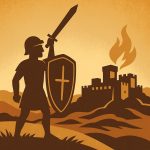| Host: | Brant Berglin |
|---|---|
| Guests: | James Ash |
| Quarter: | Allusions, Images, Symbols |
| Lesson: | 13 |
| Sabbath: | June 28th, 2025 |
Opening Question
What is the largest natural disaster you’ve experienced personally?
Introduction
Our lesson this week concludes the study of prophetic foreshadowings or types from the Old Testament that predict or hint at final events. The key here is that they show how God’s actions in history give us reasons to have hope in the future. The same struggles and victories of His people in the past are ours today.
This lesson looks at Jonah’s calling, and then takes us to Babylon to watch it fall, and reveals a pagan “Messiah” who delivered God’s people from their exile. Yes, God even uses pagan kings as His deliverers, and as foreshadows of His Son’s return!
Jonah
Once again, this is a small book, only four chapters. We see a similar narrative structure in Jonah to our explorations of Esther and Ruth. After reading through it, answer the following questions.
Many pagan cultures believed the Gods were instrumental in their daily affairs. Would their belief had been strengthened or altered after their encounter with God’s servant Jonah? What might they have learned about Jonah’s God?
Why is Jonah running? Does he actually believe he can escape the “presence of the Lord”? What does he fear, do we know?
Jonah’s poetic section in ch. 2 highlights the experience, not just of Jonah, but of Jesus, too; indeed, all who experience a death in the waters (baptism) and a rising to new life, and new purpose. What does this suggest the calling of God’s people should be after their commitment to follow Christ?
Why does Jonah become angry? With what aspects of God’s character does he find fault? He complains that he knew God was like that from the beginning!
How does God really feel about the nations? What does He want from them, as the Ninevites’ response reveals to us?
The Fall of Babylon
Revelation 17-19 describe the fall of end-time Babylon, including songs of praise from heaven and its inhabitants, and laments and dirges from the people of the earth who became rich through their relationship with her. Yet this “fall of Babylon” is not the first. In fact, there are two previous accounts of the fall of Babylon. The first is found in Genesis with the abandonment of the tower of Babel project. The second is referenced in Daniel 5. However, no historical details are given in the Biblical text of how exactly the city would be overthrown. For that, we must read Herodotus. Once we do, though, the Biblical story comes alive and with it, Revelation. Read Daniel 5, then consider the following questions:
What was the attitude of King Belshazzar compared to Nebuchadnezzar? Does he give any indication that he would repent when confronted with both the history of God in Babylon through Nebuchadnezzar, the words of the Queen (likely his own mother), and the supernatural handwriting on the wall?
Although the Biblical text does not describe the fall of Babylon, Herodotus says that King Cyrus of the Persians dried up the Euphrates river) which flowed directly under and through the old city of Babylon), and found the riverbed uncontested by defending soldiers. The city was overcome from within after the river was dried up.
Read Revelation 16, paying special attention to vss. 12-21 and answer the following questions.
How does the history of Babylon’s first fall provide a parallel for end-time Babylon?
If Babylon is no longer a literal city, of what does it become a symbol? How could that “city” fall?
The way is prepared for the “kings from the east,” it says. That king in Daniel’s story was Cyrus, who, according to Isaiah 44 and 45, becomes an “anointed” ruler sent by God. Does God still use pagan kings and kingdoms for His purposes?
If the city of Babylon in Revelation is a symbol for an end-time alliance between the kings of the world and religious power, then it stands to reason that—at some level, at least—the holy city, the New Jerusalem at the end of Revelation has some symbolic features. If you get a chance, read Revelation 21-22 and ask what the imagery there might be communicating such as, the size of the city, the need for walls, the measurements all based on 12s, and the foundation of the apostles (see references in Ephesians and Peter to the temple of God’s people).
Closing Comments
As our study this quarter ends, my hope is that this study guide and the quarterly give you greater encouragement to study your Bibles closely, comparing scripture with scripture, especially the prophetic material.
May the God of all peace, His Son Jesus Christ, and the Holy Spirit be with you as you study His word, making ready to meet Him. May that day be soon!




